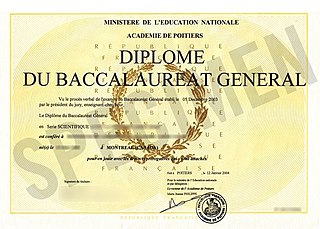The Leaving Certificate Examination, commonly referred to as the Leaving Cert or (informally) the Leaving, is the final exam of the Irish secondary school system and the university matriculation examination in Ireland. It takes a minimum of two years' preparation, but an optional Transition Year means that for those students it takes place three years after the Junior Certificate Examination. These years are referred to collectively as "The Senior Cycle." Most students taking the examination are aged 16–19; in excess of eighty percent of this group undertake the exam. The Examination is overseen by the State Examinations Commission. The Leaving Certificate Examinations are taken annually by approximately 55,000 students.
Abitur, often shortened colloquially to Abi, is a qualification granted at the end of secondary education in Germany. It is conferred on students who pass their final exams at the end of ISCED 3, usually after twelve or thirteen years of schooling. In German, the term Abitur has roots in the archaic word Abiturium, which in turn was derived from the Latin abiturus.

Matura or its translated terms is a Latin name for the secondary school exit exam or "maturity diploma" in various European countries centered around the former Austro-Hungarian Empire, including Albania, Austria, Bosnia and Herzegovina, Bulgaria, Croatia, Czechia, Hungary, Italy, Kosovo, Liechtenstein, Montenegro, North Macedonia, Poland, Serbia, Slovakia, Slovenia, Switzerland and Ukraine.

The baccalauréat, often known in France colloquially as the bac, is a French national academic qualification that students can obtain at the completion of their secondary education by meeting certain requirements. Though it has only existed in its present form as a school-leaving examination since Napoleon Bonaparte's implementation on March 17, 1808, its origins date back to the first medieval French universities. According to French law, the baccalaureate is the first academic degree, though it grants the completion of secondary education. Historically, the baccalaureate is administratively supervised by full professors at universities.

Matriculation is the formal process of entering a university, or of becoming eligible to enter by fulfilling certain academic requirements such as a matriculation examination.

The educational system in Finland consists of daycare programmes, a one-year "pre-school", and an 11-year compulsory basic comprehensive school. Nowadays secondary general academic and vocational education, higher education and adult education are compulsory.
Latin honors are a system of Latin phrases used in some colleges and universities to indicate the level of distinction with which an academic degree has been earned. The system is primarily used in the United States. It is also used in some Southeastern Asian countries with European colonial history, such as Indonesia and the Philippines, although sometimes translations of these phrases are used instead of the Latin originals. The honors distinction should not be confused with the honors degrees offered in some countries, or with honorary degrees.

Multiple choice (MC), objective response or MCQ is a form of an objective assessment in which respondents are asked to select only correct answers from the choices offered as a list. The multiple choice format is most frequently used in educational testing, in market research, and in elections, when a person chooses between multiple candidates, parties, or policies.
Tenth grade is the tenth year of formal or compulsory education. It is typically the second year of high school. In many parts of the world, students in tenth grade are usually 15 or 16 years of age.

The Hong Kong Certificate of Education Examination was a standardised examination between 1974 and 2011 after most local students' five-year secondary education, conducted by the Hong Kong Examinations and Assessment Authority (HKEAA), awarding the Hong Kong Certificate of Education secondary school leaving qualification. The examination has been discontinued in 2012 and its roles are now replaced by the Hong Kong Diploma of Secondary Education as part of educational reforms in Hong Kong. It was considered as the equivalent of the GCSE in the United Kingdom.

The National College Entrance Examination (NCEE), commonly known as the gaokao, is a standardized college entrance exam held annually in Mainland China. It is required for entrance into all higher education institutions at the undergraduate level in the country. It is usually taken by students in their third and last year of senior high school.

Te'udat Bagrut is a certificate that attests that a student has successfully passed Israel's high school matriculation examination. Bagrut is a prerequisite for higher education in Israel.
Selectividad is the popular name given to the Spanish University Admission Tests, a non-compulsory exam taken by students after secondary school, necessary to get into University. Students must take six 90-minute written exams over three days in June or September, consisting of common and specific subjects taken in "Bachillerato". Selectividad exams are set by the Public Universities of each autonomous community and allow students access to the Spanish university system.
Madhyamik Pariksha or simply Madhyamik is a centralized examination conducted by the West Bengal Board of Secondary Education in West Bengal, India, at the end of the 10th year of school education. Similarly, one examination is also conducted at the state of Tripura for its students studying in Govt or Govt Aided school under the control of Tripura Board of Secondary Education. By count of examinees, it is among the better-known 10th standard examinations in India. In WBSE, over 600,000 students took the exam in 2000, and the number has increased substantially since then. The number of students reached a record 1 million in the 2011 Madhyamik examination. Compulsory subjects are first language, second language, physical science, life science, mathematics, history and geography.
This is an article on the grading that is used in Finland. Several systems are in use in different educational institutions in Finland.
The West African Senior School Certificate Examination (WASSCE) is a type of standardized test in West Africa. Students who pass the exam receive a certificate confirming their graduation from secondary education. It is administered by the West African Examinations Council (WAEC). It is only offered to candidates residing in Anglophone West African countries. The academic school-leaving qualification awarded upon successful completion of the exams is the West African Senior School Certificate.
In South Africa, matriculation is the final year of high school and the qualification received on graduating from high school, and the minimum university entrance requirements. The first formal examination was conducted in South Africa under the University of the Cape of Good Hope in 1858. In general usage, the school-leaving exams, which are government-administered, are known as the "matric exams"; by extension, students in the final year of high school are known as "matriculants" or, more commonly, "matrics". Once the Matric year has been passed, students are said to have "matriculated". See List of secondary education systems by country § South Africa.
A matriculation examination or matriculation exam is a university entrance examination, which is typically held towards the end of secondary school. After passing the examination, a student receives a school leaving certificate recognising academic qualifications from secondary-level education. Depending on scores or grades achieved, a student may then matriculate to university to take up further studies.

The ICFESexamination, or Saber 11, is a high school exit examination administered annually in grade 11 in Colombian high schools. The exam is standardized, similar to the SAT and ACT examinations taken by high school students in the United States. The purpose of the exam is to evaluate students' aptitude in five subjects: critical reading, mathematics, social studies, science, and English. Each exam question has four multiple-choice answers, except for the English section which provides between three and eight possible answers for each question.

An examination or test is an educational assessment intended to measure a test-taker's knowledge, skill, aptitude, physical fitness, or classification in many other topics. A test may be administered verbally, on paper, on a computer, or in a predetermined area that requires a test taker to demonstrate or perform a set of skills.











